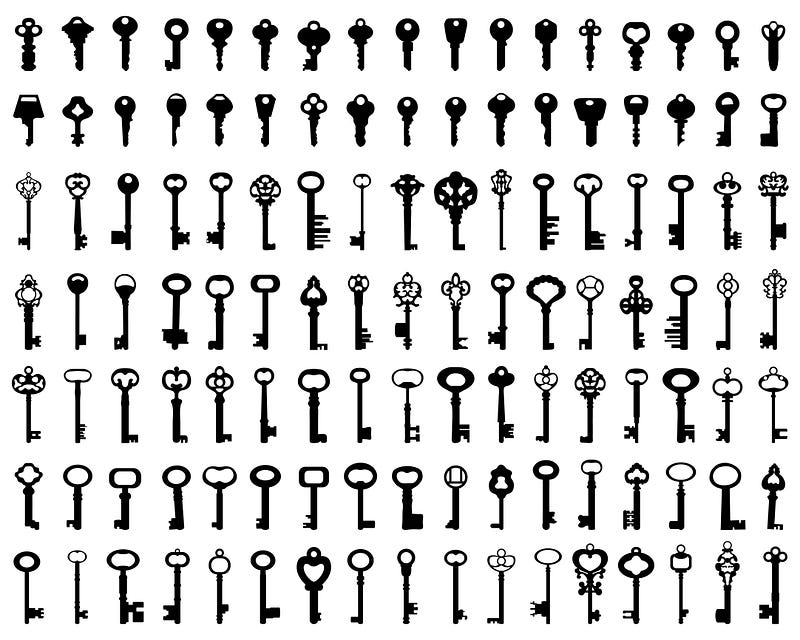So What Does an Encryption Key Look Like?

So What Does an Encryption Key Look Like?
So, what does an encryption key look like these days? Well, it depends on whether you are a computer or a human. For a computer, it is just a bunch of 1’s and 0’s, but for humans, we are not so good at interpreting binary. Two common formats are DER (binary) and PEM (Base64). When interpreted as hexadecimal, DER looks something like this [here]:

The PEM format is a little more structured with a special header and footer, and with Base64 text in between:

With elliptic curve cryptography, we start with a definition for the curve, such as:
y²=x³+ax+b (mod p)
This defines values for a, b and p. Next we select a base point on the curve (G, and generate a random scalar value (D). This is the private key, and where the public key is generated from a point multiplcation of:
Q=D.G
This results in an (x,y) point on the curve. So now, let’s generate PEM keys for most of the available elliptic curves. First, we create a folder named “bc_ec02”, and then go into that folder. We can create a Dotnet console project for .NET 8.0 with:
dotnet new console --framework net8.0Next we can install the Bouncy Castle library with:
dotnet add package BouncyCastle.Crypto.dll --version 1.8.1Next some code:
namespace ECCurves
{
using Org.BouncyCastle.Asn1.X9;
using Org.BouncyCastle.Security;
using Org.BouncyCastle.Crypto.Parameters;
using Org.BouncyCastle.OpenSsl;
class Program
{
static void Main(string[] args)
{
var curvename="secp256k1";
if (args.Length >0) curvename=args[0];
try {
X9ECParameters ecParams = ECNamedCurveTable.GetByName(curvename);
var curveparam = new ECDomainParameters(ecParams.Curve, ecParams.G, ecParams.N, ecParams.H, ecParams.GetSeed());
Org.BouncyCastle.Crypto.Parameters.ECKeyGenerationParameters keygenParams = new Org.BouncyCastle.Crypto.Parameters.ECKeyGenerationParameters (curveparam, new SecureRandom());
Org.BouncyCastle.Crypto.Generators.ECKeyPairGenerator generator = new Org.BouncyCastle.Crypto.Generators.ECKeyPairGenerator();
generator.Init(keygenParams);
var keyPair = generator.GenerateKeyPair();
var privateKey = (ECPrivateKeyParameters) keyPair.Private;
var publicKey = (ECPublicKeyParameters) keyPair.Public;
Console.WriteLine("== Curve: {0} ",curvename);
Console.WriteLine("\n== Private key === ");
Console.WriteLine("== D ==={0} ",privateKey.D.ToString());
Console.WriteLine("\n== Public key === ");
Console.WriteLine("== Q_x ==={0} ",publicKey.Q.XCoord);
Console.WriteLine("== Q_t ==={0} ",publicKey.Q.YCoord);
Console.WriteLine("\n\nCurve details: G={0}, N={1}, H={2}", ecParams.G, ecParams.N, ecParams.H);
Console.WriteLine("A={0}\nB={1}\nField size={2}",ecParams.Curve.A,ecParams.Curve.B,ecParams.Curve.FieldSize);
Console.WriteLine("\n== PEM Keys == ");
StringWriter stringWriter = new StringWriter ();
PemWriter pemWriter = new PemWriter (stringWriter);
pemWriter.WriteObject(keyPair.Private);
pemWriter.Writer.Flush();
pemWriter.Writer.Close();
Console.WriteLine("{0}",stringWriter.ToString());
StringWriter stringWriter2 = new StringWriter ();
pemWriter = new PemWriter (stringWriter2);
pemWriter.WriteObject(keyPair.Public);
pemWriter.Writer.Flush();
pemWriter.Writer.Close();
Console.WriteLine("{0}",stringWriter2.ToString());
} catch (Exception e) {
Console.WriteLine("Error: {0}",e.Message);
}
}
}
}A sample run for secp2561 gives [here]:
== Curve: secp256k1
== Private key ===
== D ===43250499650242596509689166032012670046190113460404858020166639295206771656023
== Public key ===
== Q_x ===7b95c5ca46483c9571f9e011f66bb1ddbbea0e79e862ff9be6a2dc7d6e55bf92
== Q_t ===9259573461fab4aa93bf7b4f6d4d5c05180d9b051d02f81d5b0fbf1d738da959
Curve details: G=(79be667ef9dcbbac55a06295ce870b07029bfcdb2dce28d959f2815b16f81798,483ada7726a3c4655da4fbfc0e1108a8fd17b448a68554199c47d08ffb10d4b8,1,0), N=115792089237316195423570985008687907852837564279074904382605163141518161494337, H=1
A=0
B=7
Field size=256
== PEM Keys ==
-----BEGIN EC PRIVATE KEY-----
MIIBUQIBAQQgX57qUTrWzGTaeOK0eyGIv1SaMm+vXrpB+Pj9TyOUBVeggeMwgeAC
AQEwLAYHKoZIzj0BAQIhAP////////////////////////////////////7///wv
MEQEIAAAAAAAAAAAAAAAAAAAAAAAAAAAAAAAAAAAAAAAAAAABCAAAAAAAAAAAAAA
AAAAAAAAAAAAAAAAAAAAAAAAAAAABwRBBHm+Zn753LusVaBilc6HCwcCm/zbLc4o
2VnygVsW+BeYSDradyajxGVdpPv8DhEIqP0XtEimhVQZnEfQj/sQ1LgCIQD/////
///////////////+uq7c5q9IoDu/0l6M0DZBQQIBAaFEA0IABHuVxcpGSDyVcfng
EfZrsd276g556GL/m+ai3H1uVb+SkllXNGH6tKqTv3tPbU1cBRgNmwUdAvgdWw+/
HXONqVk=
-----END EC PRIVATE KEY-----
-----BEGIN PUBLIC KEY-----
MIIBMzCB7AYHKoZIzj0CATCB4AIBATAsBgcqhkjOPQEBAiEA////////////////
/////////////////////v///C8wRAQgAAAAAAAAAAAAAAAAAAAAAAAAAAAAAAAA
AAAAAAAAAAAEIAAAAAAAAAAAAAAAAAAAAAAAAAAAAAAAAAAAAAAAAAAHBEEEeb5m
fvncu6xVoGKVzocLBwKb/NstzijZWfKBWxb4F5hIOtp3JqPEZV2k+/wOEQio/Re0
SKaFVBmcR9CP+xDUuAIhAP////////////////////66rtzmr0igO7/SXozQNkFB
AgEBA0IABHuVxcpGSDyVcfngEfZrsd276g556GL/m+ai3H1uVb+SkllXNGH6tKqT
v3tPbU1cBRgNmwUdAvgdWw+/HXONqVk=
-----END PUBLIC KEY-----And for NIST (FIPS) P-256 [here]:
== Curve: P-256
== Private key ===
== D ===86743583738379448146094505808110034179188128696718648342714252621347788199862
== Public key ===
== Q_x ===d0710c1f0d9bd54faea6e803b2aefa6e463a5fe410155ff98d6d0120dd134203
== Q_t ===ce6dc2f17010cbd776aa9143860161b9d311c6159bd8ff1bc77c976d22abdaf8
Curve details: G=(6b17d1f2e12c4247f8bce6e563a440f277037d812deb33a0f4a13945d898c296,4fe342e2fe1a7f9b8ee7eb4a7c0f9e162bce33576b315ececbb6406837bf51f5,1,ffffffff00000001000000000000000000000000fffffffffffffffffffffffc), N=115792089210356248762697446949407573529996955224135760342422259061068512044369, H=1
A=ffffffff00000001000000000000000000000000fffffffffffffffffffffffc
B=5ac635d8aa3a93e7b3ebbd55769886bc651d06b0cc53b0f63bce3c3e27d2604b
Field size=256
== PEM Keys ==
-----BEGIN EC PRIVATE KEY-----
MIIBaAIBAQQgv8cg51nFI3tl6Lh4bMbH46nPv9sR5KNjTwVGn4BAl7aggfowgfcC
AQEwLAYHKoZIzj0BAQIhAP////8AAAABAAAAAAAAAAAAAAAA////////////////
MFsEIP////8AAAABAAAAAAAAAAAAAAAA///////////////8BCBaxjXYqjqT57Pr
vVV2mIa8ZR0GsMxTsPY7zjw+J9JgSwMVAMSdNgiG5wSTamZ44ROdJreBn36QBEEE
axfR8uEsQkf4vOblY6RA8ncDfYEt6zOg9KE5RdiYwpZP40Li/hp/m47n60p8D54W
K84zV2sxXs7LtkBoN79R9QIhAP////8AAAAA//////////+85vqtpxeehPO5ysL8
YyVRAgEBoUQDQgAE0HEMHw2b1U+upugDsq76bkY6X+QQFV/5jW0BIN0TQgPObcLx
cBDL13aqkUOGAWG50xHGFZvY/xvHfJdtIqva+A==
-----END EC PRIVATE KEY-----
-----BEGIN PUBLIC KEY-----
MIIBSzCCAQMGByqGSM49AgEwgfcCAQEwLAYHKoZIzj0BAQIhAP////8AAAABAAAA
AAAAAAAAAAAA////////////////MFsEIP////8AAAABAAAAAAAAAAAAAAAA////
///////////8BCBaxjXYqjqT57PrvVV2mIa8ZR0GsMxTsPY7zjw+J9JgSwMVAMSd
NgiG5wSTamZ44ROdJreBn36QBEEEaxfR8uEsQkf4vOblY6RA8ncDfYEt6zOg9KE5
RdiYwpZP40Li/hp/m47n60p8D54WK84zV2sxXs7LtkBoN79R9QIhAP////8AAAAA
//////////+85vqtpxeehPO5ysL8YyVRAgEBA0IABNBxDB8Nm9VPrqboA7Ku+m5G
Ol/kEBVf+Y1tASDdE0IDzm3C8XAQy9d2qpFDhgFhudMRxhWb2P8bx3yXbSKr2vg=
-----END PUBLIC KEY-----Conclusions
And, so, PEM are great ways to ensapsulate keys.